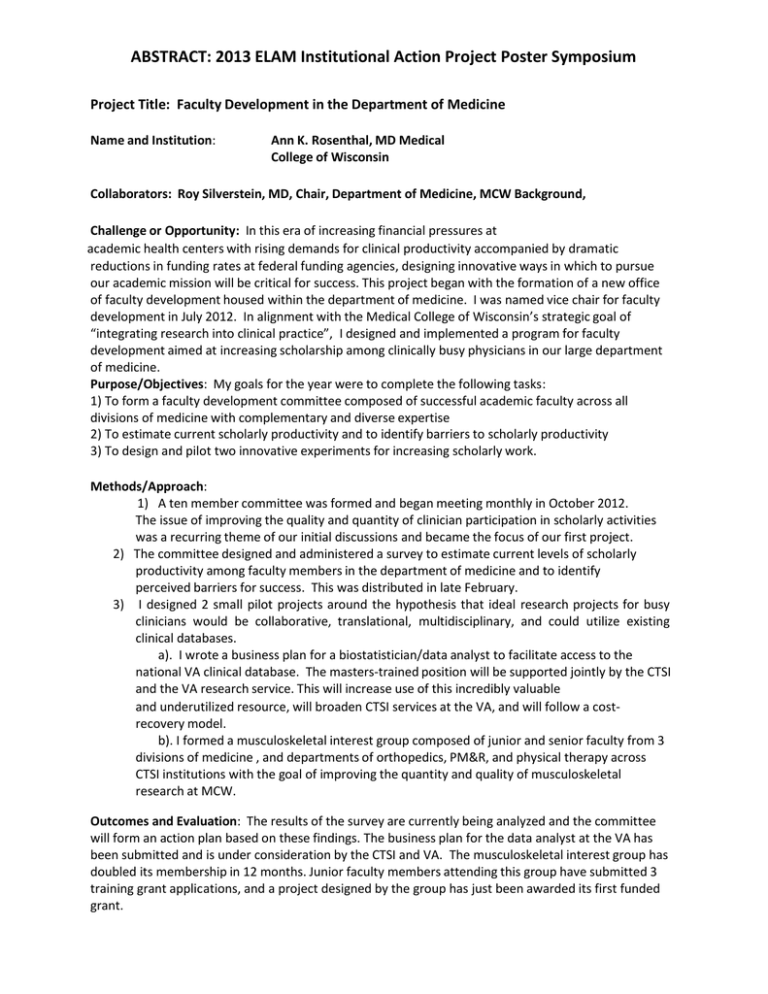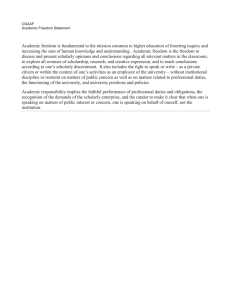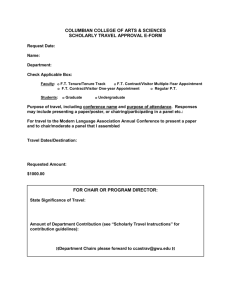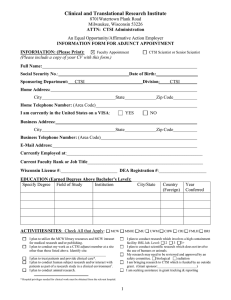ABSTRACT: 2013 ELAM Institutional Action Project Poster Symposium
advertisement

ABSTRACT: 2013 ELAM Institutional Action Project Poster Symposium Project Title: Faculty Development in the Department of Medicine Name and Institution: Ann K. Rosenthal, MD Medical College of Wisconsin Collaborators: Roy Silverstein, MD, Chair, Department of Medicine, MCW Background, Challenge or Opportunity: In this era of increasing financial pressures at academic health centers with rising demands for clinical productivity accompanied by dramatic reductions in funding rates at federal funding agencies, designing innovative ways in which to pursue our academic mission will be critical for success. This project began with the formation of a new office of faculty development housed within the department of medicine. I was named vice chair for faculty development in July 2012. In alignment with the Medical College of Wisconsin’s strategic goal of “integrating research into clinical practice”, I designed and implemented a program for faculty development aimed at increasing scholarship among clinically busy physicians in our large department of medicine. Purpose/Objectives: My goals for the year were to complete the following tasks: 1) To form a faculty development committee composed of successful academic faculty across all divisions of medicine with complementary and diverse expertise 2) To estimate current scholarly productivity and to identify barriers to scholarly productivity 3) To design and pilot two innovative experiments for increasing scholarly work. Methods/Approach: 1) A ten member committee was formed and began meeting monthly in October 2012. The issue of improving the quality and quantity of clinician participation in scholarly activities was a recurring theme of our initial discussions and became the focus of our first project. 2) The committee designed and administered a survey to estimate current levels of scholarly productivity among faculty members in the department of medicine and to identify perceived barriers for success. This was distributed in late February. 3) I designed 2 small pilot projects around the hypothesis that ideal research projects for busy clinicians would be collaborative, translational, multidisciplinary, and could utilize existing clinical databases. a). I wrote a business plan for a biostatistician/data analyst to facilitate access to the national VA clinical database. The masters-trained position will be supported jointly by the CTSI and the VA research service. This will increase use of this incredibly valuable and underutilized resource, will broaden CTSI services at the VA, and will follow a costrecovery model. b). I formed a musculoskeletal interest group composed of junior and senior faculty from 3 divisions of medicine , and departments of orthopedics, PM&R, and physical therapy across CTSI institutions with the goal of improving the quantity and quality of musculoskeletal research at MCW. Outcomes and Evaluation: The results of the survey are currently being analyzed and the committee will form an action plan based on these findings. The business plan for the data analyst at the VA has been submitted and is under consideration by the CTSI and VA. The musculoskeletal interest group has doubled its membership in 12 months. Junior faculty members attending this group have submitted 3 training grant applications, and a project designed by the group has just been awarded its first funded grant. ABSTRACT: 2013 ELAM Institutional Action Project Poster Symposium Faculty Development in a Department of Medicine Ann K Rosenthal,MD, Chief, Division of Rheumatology, Vice Chair for Faculty Development Medical College of Wisconsin Roy Silverstein, MD, Chair, Department of Medicine, Medical College of Wisconsin Background, Challenge or Opportunity: Purpose/Objectives: In this era of increasing financial pressures at academic health centers with rising demands for clinical productivity accompanied by dramatic reductions in funding rates at federal funding agencies, designing innovative ways in which to pursue our academic mission will be critical for success. This project began with the formation of a new office of faculty development housed within the department of medicine. I was named vice chair for faculty development in July 2012. In alignment with the Medical College of Wisconsin’s strategic goal of “integrating research into clinical practice”, I designed and implemented a program for faculty development aimed at increasing scholarship among clinically busy physicians in our large department of medicine. My goals for the year were to complete the following tasks: 1) To form a committee composed of successful academic faculty across all divisions of medicine with complementary and diverse expertise 2) To estimate current scholarly productivity in the department and to identify barriers to scholarly productivity 3) To design and pilot two innovative experiments for increasing scholarly work. Do you feel you have adequate support in the DOM for academic pursuits? Methods/Approach: 1. A ten member committee was formed and began meeting monthly in October 2012. The issue of improving the quality and quantity of clinician participation in scholarly activities was a recurring theme of our initial discussions and became the focus of our first project. 2. The committee designed and administered a survey to estimate current levels of scholarly productivity among faculty members in the department of medicine and to identify perceived barriers for success. This was distributed in late February. 3. I designed 2 small pilot projects around the hypothesis that ideal research projects for busy clinicians would be collaborative, translational, multidisciplinary, and could utilize existing clinical databases. a). I wrote a business plan for a biostatistician/data analyst to facilitate access to the national VA clinical database. The masters-trained position will be supported jointly by the CTSI and the VA research service. This will increase use of this incredibly valuable and underutilized resource, will broaden CTSI services at the VA, and will follow a cost-recovery model. b). I formed a musculoskeletal interest group composed of junior and senior faculty from 3 divisions of medicine, and departments of orthopedics, PM&R, and physical therapy across our local CTSI institutions with the goal of improving the visibility, quantity and quality of musculoskeletal research at our institution. If the DOM provided assistance with technical, biostatistical, database searching, or research-focused administrative help, would you use it? Perceived reasons for lack of scholarly productivity Lack of collaborators Lack of mentorship Lack of technical, biostatistical or administrative Help Difficulties with the IRB Unsure how to translate ideas into grants and papers Lack of reward (monetary or other) for these activities (i.e. no point) Other Lack of access to or knowledge about using existing clinical Databases Difficulties with the eBridge system Lack of ideas Lack of interest in these activities 35.1% 35.1% 31.2% 28.6% 28.6% 27.3% 27.3% Yes Yes No No 23.4% 14.3% 10.4% 10.4% Outcomes and Evaluation: • The results of the survey are currently being analyzed and the committee will form an action plan based on these findings. What is your current rank ? • The business plan for the data analyst at the VA has been submitted and is under consideration by the CTSI and VA. What is your gender? Clinical Instructor Assistant Professor Associate Professor Professor Female Male • The musculoskeletal interest group has doubled its membership in 12 months. Junior faculty members attending this group have submitted 3 training grant applications, and a project designed by the group has just been awarded its first funded grant. Presented at the 2013 ELAM® Leaders Forum




